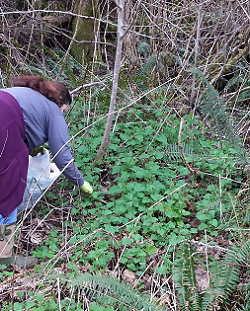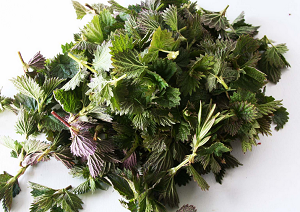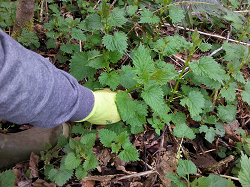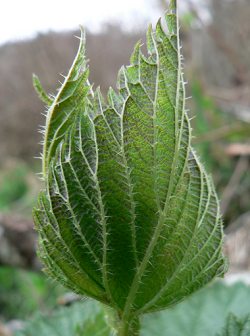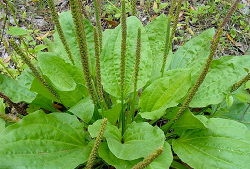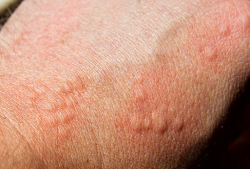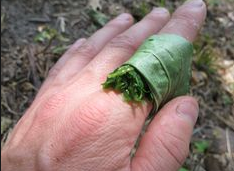 Loading... Please wait...
Loading... Please wait...Stinging Nettles: A weed worth foraging!
Posted by Patricia Delgado on 22nd Mar 2015
Until recent…before I started my research and decided to offer herbal advice and remedies…to me, nettles have always been a little like willow bark — something I’ve gone through life vaguely knowing was medicinal, yet I’d never really bothered to get around to picking and using what my Oma called “Brennnesseln” or what my Opa use to threaten to spank me with when I stepped out of line!
Ironically, the first part is still true.
Did I want to find some? “Heck, yes!” And I was pleasantly surprised to see nettles all along the path up to the top of the mountain we were hiking up. What most people call weeds is really a super-food. I've read differing accounts (thanks, Internet) of their value, anywhere from 20-40% protein, with high levels of vitamins A, B, and C, and possibly some minerals (iron, I've been told and read). I'm no nutritionist, but I do know that greens are good for you (that’s what my Oma always told me anyways!). I found a good selection of medicinal recipes as well as dinner side dish ideas.
Once we made it to the “Y” in the old logging road, (This was my goal to reach that day) Jim and I put our gloves on and pulled our clippers out and tackled the patches of nettles. A couple of hours later we started our hike down the mountain and returned to our farmstead with two grocery bags full of nettle tops. Score!
Because of going out and foraging, this is why I believe we have the freshest wild harvest here at Mountain Maus’ Remedies! I emptied one bag and began trimming the leaves from the stems and carefully laying them in my dehydrator to dry, and then cut and sift. I also made a huge batch of Tincture. The cut and dried Nettle leaves can be found here and the Nettle Tincture can be found here. I’m so excited to share all this medicinal freshness with my customers!
We harvested approximately 15 pounds of fresh cut nettles, about 6 hours of trimming the leaves from the stems and another 3 hours of drying then the cutting and sifting. When the whole process was completed, we ended up with 2 lbs of dried very fresh and healthy nettles.
This is your standard prep when dealing with nettles. Is it worth it? You bet. Unlike Willow's, there is no shortage of information about the benefits of Urtica dioica, the common stinging nettle. They are unusually high in protein for a green plant. Nettles are also very high in vitamin C and A, iron, fiber and a bunch of other goodies. They've often been called a “super food” for this reason.
For those of you who want to forage for your own nettles, here are a few things to consider:
- Do you need it? Harvest with a purpose or plan in mind, not
just for the fun of it.
- Harvest only as much as you will use and process it as soon as
possible (don’t waste it).
- 1 in 20 rule. It is ok to harvest a plant if there are 20
others available to maintain the population.
- Leave the Grandmother. Allow the biggest and best plants to
remain so they can continue to propagate the healthiest population.
- Leave damaged plants or plants with “residents.” Select
quality material for your food and medicine. If a critter makes it’s home
there, choose another. Harvest 1/3 or less of an individual plant (leave
some roots) so it can continue to survive and thrive.
- Harvest with a clean cut so the plant will heal well and continue
to survive and thrive.
- Avoid polluted areas.
- Offer appreciation and bring positive energy to your harvest.
- Never put anything in your mouth unless you are 100% sure it is
safe to ingest.
Here are a few tidbits on Stinging Nettles.
How do I identify Stinging Nettle?
Fortunately stinging nettle has a distinctive look to it. The leaves and stem are vibrant green and pubescent (hairy), sometimes with a hint of purple. As the nettle grows, the strongly serrate/toothed margins or edges of the leaves become more evident. Each leaf has a twin on the opposite side of the erect central stem and they’re arranged such that one pair is in the 12 and 6 o’clock positions. The next set down is slightly larger and is at 3 and 9 o’clock. The next set down is even larger and back at 12 and 6 o’clock, and so on. The leaves have a characteristic heart shape to them with a small stem attaching the cleft or top of the heart to the central stem. The base or point of the heart aims away from the central stem.
By late spring, the nettles are 3 to 6+ feet high, the largest leaves are upwards of 7 inches long and they are flowering lovely whitish/greenish inflorescence's or clusters. These clusters will soon go to seed and become slightly brown. And as late summer turns to autumn, the leaves will wither and fall and the stems will turn from green to brown to whitish/gray as they overwinter. The bare stalks may decompose completely before new leaves emerge from the underground rhizomes or they may remain to oversee the beginning of the next generation of foliage.
If you are still unsure whether a plant is indeed a
stinging nettle, you can opt to touch it and see what happens. If you feel a sting/slight burning feeling
and possibly even a small welt which may arise, then you have confirmation of
the plant’s identity! If not, then
perhaps you could consult a field guide such as Plants of the
You may harvest nettles from the time the new leaves emerge from the ground until late fall after the flowers have gone to seed but before the rains begin to rot the stems (while they still maintain their green color and have leaves attached). It all depends upon your goal. If you would like to use nettles for food or tea, then harvest them before they flower. Fortunately, individual plants will often be at different reproductive stages depending on their location. So, look around and you can usually find some that you can still harvest where others are not.
How do I harvest Stinging Nettle without getting stung?
The easy answer is to use scissors and wear long sleeves, long pants and work gloves. But it’s much more interesting to harvest nettles when you understand how the stinging process works and learn how to handle them without getting stung. When looking at a stinging nettle, you can see little hairs on the stem and leaves. These hairs are hollow and when they get under your skin, the tips break off and allow the formic acid (among other things) under your skin. Now I don’t know if every hair is hollow or if every hollow hair has acid associated with it. I do know that sometimes the lightest touch will get you stung and sometimes it takes effort to get stung. The key is that the hairs on the leaves all aim from the cleft or top of the leaf to the point or bottom of the leaf. If you run your finger from cleft to point, you will not get stung and you will impress your friends. If you run your finger from the pointy end up toward the cleft and central stem, chances are excellent you will get stung. It’s as simple as that.
Let’s imagine you want to harvest some nettles, and you have your scissors but forgot your gloves (something I DO NOT recommend). No problem, because you know the secret (or you pull your sleeves down over your fingers). All you to do is cut the portion you need, hover your fingers above and below the leaf, then pinch it. Ta-Da, no sting, because you know the hairs don’t point straight out, they angle down the leaf. All you've done is press them flat against the leaf where they cannot poke you. Good job! Now you can place the nettle in your collecting bag and continue harvesting. If you've forgotten your scissors, you can harvest leaf by leaf (but that takes a long time). If you choose to go this route, be extra careful, I speak from experience, no matter how much experience you have, you will experience some stinging. When you select your leaf and pinch it, look at the location of the nearby leaves before you pull it from the stem. Beware the smaller upper leaves that dangle down and zap the top of your hand. And be mindful of the larger lower leaves that sneak out and get you on the wrist as you’re watching out for the wily upper leaves. Stinging nettle is a plant that demands respect so be sure to do so.
What part do I harvest?
I harvest the tender tops (usually 4-6 leaves or 2-3 leaf sets). There are a number of species of moth and butterfly larvae that feed on nettles. Check the terminal (top) bud for signs of little six legged creatures before harvesting. It just takes a quick glance to notice that the tips or leaves has been chewed on, is slightly blackened or there is bug poop (waste material from plant-eating insects) visible. If the nettles are very young then I only harvest the top bud and first leaf set. Harvesting the terminal (top) bud will stimulate lateral bud growth causing the plant to become bushier and allowing you to harvest continually from the same plant all summer long.
What do I do if I get stung by a Stinging Nettle?
Plantain is one of the many potential natural remedies for a stinging nettle sting. It works for me every time!Getting stung is a bit of a pain (no pun intended) but not a very big deal. And, it’s certainly not enough of a negative to keep me from harvesting and enjoying these amazing plants. I rarely get stung, (I am kidding!), but when I do there are a few natural remedies nearby that I like to use. You’ll find that different remedies work for different people, so you may have to try a few to find what works for you. Some swear that mud does the trick for them, but it doesn't do a thing for me except get me dirty. My #1 go-to plant to stop the sting is Plantain. Simply pick a couple of fresh leaves (usually growing close to where you are harvesting) put them in your mouth and chew (making a spit poultice) till its wet and yucky, then rub it on and the sting is eliminated. Others crush and apply Yellow Dock leaves or rub the welt/sting with the spores on the under side of Sword Fern leaves. And, if you’re so inclined, you can smash some of the stems with a rock and apply the juice from the plant that stung you or from it’s roots. If you’re close to home, you can apply aloe vera gel, make and apply a paste of baking soda and water, apple cider vinegar, Desitin (diaper rash cream), tooth paste, etc. I encourage you not only to research (field guide or online) the plant remedies listed above, but go outside and look around to make sure you can identify them in the field where you’ll actually be when you need them.
My final notes on Stinging Nettles:
The internet boasts many medicinal uses for stinging nettle which may or may not be true. I encourage you to do your research by finding reputable and independent sources of information. Don’t take my work for it or my using my husband and children as guinea pigs, consider working with a respected herbalist or naturopathic physician in your area – someone who uses plants as medicine on a regular basis and knows from experience what they will and will not do.

